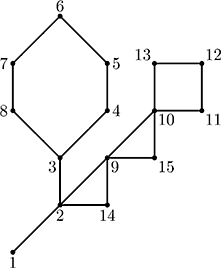 |
| ||||
Home Page
F.A.Qs
Statistical Charts
Past Contests
Scheduled Contests
Award Contest
| ||||||||||
| Online Judge | Problem Set | Authors | Online Contests | User | ||||||
|---|---|---|---|---|---|---|---|---|---|---|
| Web Board Home Page F.A.Qs Statistical Charts | Current Contest Past Contests Scheduled Contests Award Contest | |||||||||
|
Language: Cactus Reloaded
Description Cactus is a connected undirected graph in which every edge lies on at most one simple cycle. Intuitively cactus is a generalization of a tree where some cycles are allowed. Your task is to find a diameter of the given cactus. Diameter is the maximal length of the shortest path between pairs of vertices.  For example, on the picture above the shortest path between vertices 6 and 12 goes through 8 edges and it is the maximal shortest path in this graph, thus its diameter is 8. Input The first line of the input file contains two integer numbers n and m (1 ≤ n ≤ Each of the following m lines contains a path in the graph. A path starts with an integer number ki (2 ≤ ki ≤ 1000) followed by ki integers from 1 to n. These ki integers represent vertices of a path. Adjacent vertices in a path are distinct. Path can go to the same vertex multiple times, but every edge is traversed exactly once in the whole input file. There are no multiedges in the graph (there is at most one edge between any two vertices). The graph in the input file is a cactus. Output Write to the output file a single integer number — the diameter of the given cactus. Sample Input 15 3 9 1 2 3 4 5 6 7 8 3 7 2 9 10 11 12 13 10 5 2 14 9 15 10 Sample Output 8 Source | ||||||||||
[Submit] [Go Back] [Status] [Discuss]
All Rights Reserved 2003-2013 Ying Fuchen,Xu Pengcheng,Xie Di
Any problem, Please Contact Administrator